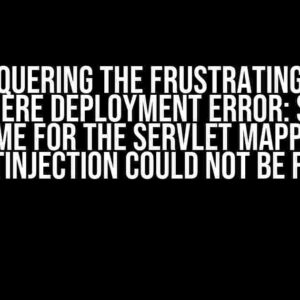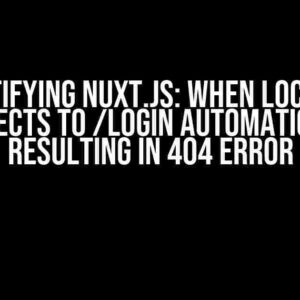When it comes to handling concurrent requests in a servlet-based application, spawning new threads from a servlet might seem like a straightforward solution. However, this approach can lead to a plethora of problems that can compromise the performance, scalability, and reliability of your application. In this article, we’ll delve into the common issues that arise from spawning new threads from a servlet and explore alternative approaches that can help you avoid these pitfalls.
Problems with Spawning New Threads from a Servlet
Here are some of the key problems you may encounter when spawning new threads from a servlet:
- Resource Starvation: Each new thread consumes system resources such as memory, CPU cycles, and file handles. If you’re not careful, you might end up exhausting these resources, leading to performance degradation, slow responses, or even crashes.
- Context Switching Overhead: When the servlet spawns new threads, the Java Virtual Machine (JVM) needs to perform context switching, which incurs an overhead in terms of CPU cycles and memory. This overhead can add up quickly, affecting the overall performance of your application.
- Lifetime and Garbage Collection: Threads created by a servlet have the same lifetime as the servlet itself. When the servlet is shut down or restarted, these threads may not be garbage collected, leading to resource leaks and potential issues.
- Servlet Container Constraints: Most servlet containers, such as Apache Tomcat, have limitations on the number of threads that can be spawned. Exceeding these limits can result in errors, crashes, or even security vulnerabilities.
- Lost or Duplicate Requests: When multiple threads are spawned to handle concurrent requests, there’s a risk of losing or duplicating requests, leading to inconsistent application behavior and data integrity issues.
Alternatives to Spawning New Threads from a Servlet
Luckily, there are alternative approaches that can help you avoid the problems associated with spawning new threads from a servlet:
1. Using Java Executors
Java provides an executor framework that allows you to manage threads in a controlled manner. You can use ExecutorService to submit tasks to be executed by a pool of threads, ensuring that the number of threads is capped and resources are utilized efficiently.
<%= imports %>
import java.util.concurrent.ExecutorService;
import java.util.concurrent.Executors;
public class MyServlet extends HttpServlet {
private ExecutorService executor;
public void init(ServletConfig config) {
executor = Executors.newFixedThreadPool(10); // Create a thread pool with 10 threads
}
public void doGet(HttpServletRequest req, HttpServletResponse resp) {
Runnable task = new MyTask(req, resp); // Create a task to be executed
executor.submit(task); // Submit the task to the executor
}
public void destroy() {
executor.shutdown(); // Shutdown the executor when the servlet is destroyed
}
}
2. Leveraging Servlet 3.0 Asynchronous Processing
Servlet 3.0 introduced asynchronous processing, which allows you to handle requests in a non-blocking manner. This approach enables you to process requests in the background, releasing the servlet thread to handle other requests.
<%= imports %>
import javax.servlet.AsyncContext;
import javax.servlet.ServletException;
import java.io.IOException;
public class MyServlet extends HttpServlet {
public void doGet(HttpServletRequest req, HttpServletResponse resp) throws ServletException, IOException {
AsyncContext asyncContext = req.startAsync(); // Start asynchronous processing
asyncContext.start(new MyAsyncTask(req, resp)); // Start the asynchronous task
}
}
class MyAsyncTask implements Runnable {
private AsyncContext asyncContext;
public MyAsyncTask(AsyncContext asyncContext) {
this.asyncContext = asyncContext;
}
public void run() {
// Perform the long-running task here
asyncContext.complete(); // Complete the asynchronous processing
}
}
3. Utilizing Java EE Concurrency API
Java EE provides a concurrency API that allows you to execute tasks asynchronously using managed threads. This approach is similar to using an executor, but with the added benefit of being managed by the application server.
<%= imports %>
import javax.enterprise.concurrent.ManagedExecutorService;
import javax.enterprise.concurrent.ManagedTask;
@Stateless
public class MyAsyncBean {
@Resource
private ManagedExecutorService executor;
public void executeTask(ManagedTask task) {
executor.submit(task); // Submit the task to the managed executor
}
}
4. Employing Message-Driven Beans
Message-driven beans (MDBs) are a type of enterprise Java bean that can be used to process messages asynchronously. You can use MDBs to handle requests in a decoupled manner, allowing your servlet to focus on handling other requests.
<%= imports %>
import javax.ejb.MessageDriven;
import javax.jms.Message;
import javax.jms.MessageListener;
@MessageDriven
public class MyMDB implements MessageListener {
public void onMessage(Message message) {
// Process the message here
}
}
| Approach | Advantages | Disadvantages |
|---|---|---|
| Java Executors | Easy to implement, flexible thread management | Requires manual thread pool management, may lead to resource leaks |
| Servlet 3.0 Asynchronous Processing | Native support in servlet containers, easy to implement | Limited control over thread management, may not be suitable for complex tasks |
| Java EE Concurrency API | Managed threads, easy to implement, scalable | Requires Java EE container, may have overhead due to container management |
| Message-Driven Beans | Decoupled, scalable, easy to implement | Requires Java EE container, may have overhead due to JMS management |
In conclusion, while spawning new threads from a servlet might seem like a simple solution, it can lead to a host of problems that can compromise the performance and reliability of your application. By leveraging alternative approaches such as Java executors, servlet 3.0 asynchronous processing, Java EE concurrency API, and message-driven beans, you can ensure that your application is scalable, efficient, and easy to maintain.
Remember to carefully evaluate the requirements of your application and choose the approach that best fits your needs. With the right approach, you can ensure that your application is capable of handling concurrent requests with ease, providing a better user experience and boosting your business’s bottom line.
Frequently Asked Question
Are you stuck with spawning a set of new threads from a Servlet and wondering what problems you might encounter and what alternatives exist? Well, you’re in luck because we’ve got the answers right here!
What are the problems with spawning a set of new threads from a Servlet?
Spawning a set of new threads from a Servlet can lead to a plethora of problems, including thread-safety issues, resource starvation, and potential platform limitations. Additionally, managing thread pools and thread lifecycle can be a nightmare, and improper thread management can lead to application crashes or poor performance.
Will spawning new threads from a Servlet affect the container’s thread pool?
Yes, spawning new threads from a Servlet can indeed affect the container’s thread pool. By creating new threads, you’re essentially stealing threads from the container’s pool, which can lead to thread starvation and performance issues. This is especially true if you’re using a container-managed thread pool.
What are some alternatives to spawning new threads from a Servlet?
One popular alternative is to use asynchronous Servlets, which allow you to write asynchronous code without the need for manual thread management. Another option is to leverage the power of ExecutorServices, which provide a higher-level abstraction for thread management. You can also consider using Java-based APIs like Spring or Java EE Concurrency Utilities for asynchronous programming.
Can I use a thread pool managed by the Servlet container?
Yes, most Servlet containers provide a managed thread pool that you can leverage for asynchronous processing. For example, in Java EE, you can use the @Async annotation or inject an ExecutorService instance to utilize the container-managed thread pool. This approach allows you to offload tasks without worrying about manual thread management.
What’s the best approach for handling long-running tasks in a Servlet-based application?
The best approach is to use an asynchronous processing model, where long-running tasks are offloaded to a separate thread or executor service. This allows the Servlet to return immediately, freeing up resources and improving overall application responsiveness. You can also consider using message queues or asynchronous APIs to handle long-running tasks.







